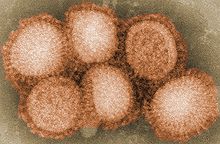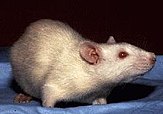Strain (biology)
Inbiology,astrainis a genetic variant, a subtype ora culturewithin a biologicalspecies.Strains are often seen as inherently artificial concepts, characterized by a specific intent for genetic isolation.[1]This is most easily observed inmicrobiologywhere strains are derived from a single cellcolonyand are typically quarantined by the physical constraints of aPetri dish.Strains are also commonly referred to withinvirology,botany,and withrodents used in experimental studies.[citation needed]
Microbiology and virology
[edit]
It has been said that "there is no universally accepted definition for the terms 'strain', 'variant', and 'isolate' in the virology community, and most virologists simply copy the usage of terms from others ".[2]
A strain is ageneticvariant or subtype of a microorganism (e.g., avirus,bacteriumorfungus). For example, a "flu strain" is a certain biological form of theinfluenzaor "flu" virus. These flu strains are characterized by their differing isoforms of surface proteins. New viral strains can be created due to mutation or swapping of genetic components when two or more viruses infect the same cell in nature.[3]These phenomena are known respectively asantigenic driftandantigenic shift.Microbial strains can also be differentiated by their genetic makeup using metagenomic methods to maximize resolution within species.[4]This has become a valuable tool to analyze themicrobiome.[citation needed]
Artificial constructs
[edit]Scientists have modified strains of viruses in order to study their behavior, as in the case of theH5N1influenza virus. While funding for such research has aroused controversy at times due to safety concerns, leading to a temporary pause, it has subsequently proceeded.[5][6]
In biotechnology, microbial strains have been constructed to establish metabolic pathways suitable for treating a variety of applications.[7]Historically, a major effort of metabolic research has been devoted to the field of biofuel production.[8]Escherichia coliis most common species for prokaryotic strain engineering. Scientists have succeeded in establishing viable minimal genomes from which new strains can be developed.[9]These minimal strains provide a near guarantee that experiments on genes outside the minimal framework will not be effected by non-essential pathways. Optimized strains ofE. coliare typically used for this application.E. coliare also often used as a chassis for the expression of simple proteins. These strains, such as BL21, are genetically modified to minimize protease activity, hence enabling potential for high efficiency industrial scaleprotein production.[10]
Strains ofyeastsare the most common subjects of eukaryotic genetic modification, especially with respect toindustrial fermentation.[11]
Plants
[edit]The term has no official ranking status in botany; the term refers to the collective descendants produced from a common ancestor that share a uniform morphological or physiological character.[12]A strain is a designated group of offspring that are either descended from a modified plant (produced by conventional breeding or by biotechnological means), or which result from genetic mutation.[citation needed]
As an example, somericestrains are made by inserting newgeneticmaterial into a rice plant,[13]all thedescendantsof the genetically modified rice plant are a strain with uniquegenetic informationthat is passed on to later generations; the strain designation, which is normally a number or a formal name, covers all the plants that descend from the originally modified plant. The rice plants in the strain can be bred to other rice strains orcultivars,and if desirable plants are produced, these are further bred to stabilize the desirable traits; the stabilized plants that can be propagated and "come true" (remain identical to the parent plant) are given acultivarname and released into production to be used by farmers.[citation needed]
Rodents
[edit]
Alaboratory mouseorratstrain is a group of animals that isgeneticallyuniform. Strains are used in laboratory experiments. Mouse strains can beinbred,mutated,orgenetically modified,while rat strains are usuallyinbred.A given inbred rodent population is considered genetically identical after 20 generations of sibling-mating. Many rodent strains have been developed for a variety of disease models, and they are also often used to test drug toxicity.[14][15][16]
Insects
[edit]Thecommon fruit fly(Drosophila melanogaster) was among the first organisms used forgenetic analysis,has a simplegenome,and is very well understood. It has remained a popular model organism for many other reasons, like the ease of its breeding and maintenance, and the speed and volume of its reproduction. Various specific strains have been developed, including a flightless version with stunted wings (also used in the pet trade aslive foodfor small reptiles and amphibians).[citation needed]
See also
[edit]References
[edit]- ^DIJKSHOORN, L.; URSING, B.M.; URSING, J.B. (2000)."Strain, clone and species: comments on three basic concepts of bacteriology".Journal of Medical Microbiology.49(5): 397–401.doi:10.1099/0022-1317-49-5-397.PMID10798550.
- ^Kuhn, Jens H.; Bao, Yiming; Bavari, Sina; Becker, Stephan; Bradfute, Steven; Brister, J. Rodney; Bukreyev, Alexander A.; Chandran, Kartik; Davey, Robert A.; Dolnik, Olga; Dye, John M.; Enterlein, Sven; Hensley, Lisa E.; Honko, Anna N.; Jahrling, Peter B.; Johnson, Karl M.;Kobinger, Gary;Leroy, Eric M.; Lever, Mark S.; Mühlberger, Elke; Netesov, Sergey V.; Olinger, Gene G.; Palacios, Gustavo; Patterson, Jean L.; Paweska, Janusz T.; Pitt, Louise; Radoshitzky, Sheli R.; Saphire, Erica Ollmann; Smither, Sophie J.; Swanepoel, Robert; Towner, Jonathan S.; van der Groen, Guido; Volchkov, Viktor E.; Wahl-Jensen, Victoria; Warren, Travis K.; Weidmann, Manfred; Nichol, Stuart T. (2012)."Virus nomenclature below the species level: a standardized nomenclature for natural variants of viruses assigned to the family Filoviridae".Archives of Virology.158(1): 301–311.doi:10.1007/s00705-012-1454-0.ISSN0304-8608.PMC3535543.PMID23001720.
- ^Yong, Ed (2013). "Scientists create hybrid flu that can go airborne".Nature.doi:10.1038/nature.2013.12925.S2CID181077199.
- ^Marx, Vivien (2016-04-28)."Microbiology: the road to strain-level identification".Nature Methods.13(5): 401–404.doi:10.1038/nmeth.3837.PMID27123815.
- ^Butler, Declan (2012). "Scientists call for 60-day suspension of mutant flu research".Nature.doi:10.1038/nature.2012.9873.S2CID84203734.
- ^"Mutant flu".Nature News Special.Retrieved21 April2019.
- ^Lee, Sang Yup (2012-11-16)."Metabolic altered and Synthetic Biology in Strain Development".ACS Synthetic Biology.1(11): 491–492.doi:10.1021/sb300109d.PMID23656224.
- ^Liu, Tiangang; Khosla, Chaitan (2010-11-03). "Genetic modification ofEscherichia colifor Biofuel Production ".Annual Review of Genetics.44(1): 53–69.doi:10.1146/annurev-genet-102209-163440.ISSN0066-4197.PMID20822440.
- ^Sung, Bong Hyun; Choe, Donghui; Kim, Sun Chang; Cho, Byung-Kwan (2016-11-30)."Construction of a minimal genome as a chassis for synthetic biology".Essays in Biochemistry.60(4): 337–346.doi:10.1042/ebc20160024.ISSN0071-1365.PMID27903821.
- ^Jeong, H; Kim, HJ; Lee, SJ (19 March 2015)."Complete Genome Sequence ofEscherichia coliStrain BL21 ".Genome Announcements.3(2).doi:10.1128/genomeA.00134-15.PMC4395058.PMID25792055.
- ^Steensels, Jan; Snoek, Tim; Meersman, Esther; Nicolino, Martina Picca; Voordeckers, Karin; Verstrepen, Kevin J. (2014-09-01)."Improving industrial yeast strains: exploiting natural and artificial diversity".FEMS Microbiology Reviews.38(5): 947–995.doi:10.1111/1574-6976.12073.ISSN0168-6445.PMC4293462.PMID24724938.
- ^Usher, George (1996),The Wordsworth Dictionary of Botany,Ware, Hertfordshire: Wordsworth Reference, p. 361,ISBN978-1-85326-374-3
- ^Maugh II, Thomas H. (18 February 2008)."Geneticist shaped hybrid rice strains - Los Angeles Times".Los Angeles Times.
- ^Anderson, Mark S.; Bluestone, Jeffrey A. (2004-11-29). "THE NOD MOUSE: A Model of Immune Dysregulation".Annual Review of Immunology.23(1): 447–485.doi:10.1146/annurev.immunol.23.021704.115643.ISSN0732-0582.PMID15771578.
- ^Cheon, Dong-Joo; Orsulic, Sandra (2011-01-24). "Mouse Models of Cancer".Annual Review of Pathology: Mechanisms of Disease.6(1): 95–119.doi:10.1146/annurev.pathol.3.121806.154244.ISSN1553-4006.PMID20936938.
- ^Yang, Guang; Zhao, Lifen; Liu, Bing; Shan, Yujia; Li, Yang; Zhou, Huimin; Jia, Li (2018). "Nutritional support contributes to recuperation in a rat model of aplastic anemia by enhancing mitochondrial function".Nutrition.46:67–77.doi:10.1016/j.nut.2017.09.002.PMID29290359.
